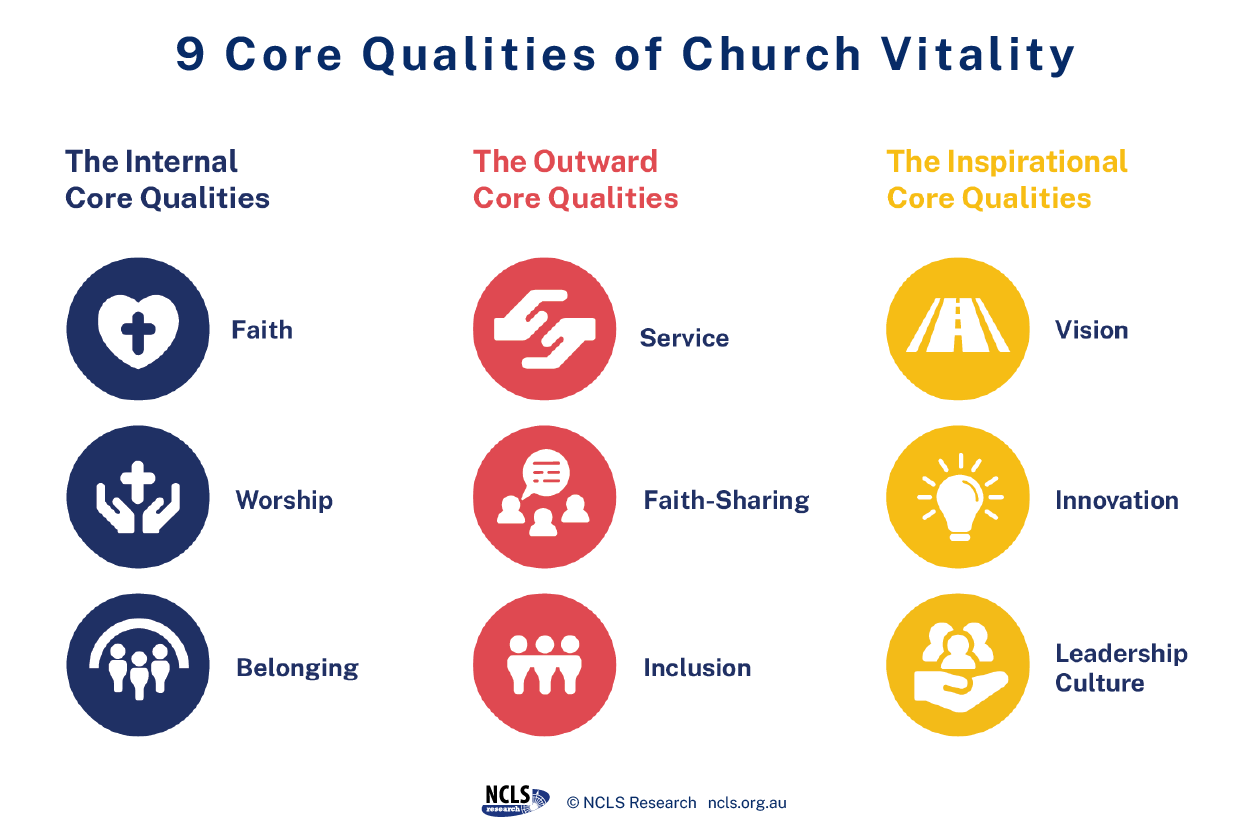Church health in nine core qualities
NCLS Research measures church vitality in 9 core areas of church life
Over 30 years NCLS Research has identified 9 Core Qualities shown to be central to the life or a vital and healthy church. The blend of these qualities points to the unique character of each church, its areas of strength and its potential for growth.
Core Qualities Model:
The Core Qualities model was developed from the 1991 National Church Life Survey (Kaldor et al, 1992) onwards and involve 20+ denominations. The responses were based on the perspectives of people in the pews. There have been various configurations but the same core concepts have remained. This is primarily large-scale quantitative research, with both strengths and limitations.
These Core Qualities are measured and grouped into three areas of church life: internal, outward and inspirational.


Alive and growing faith
A growing, lively faith is at the heart of church vitality. A primary purpose of churches is to teach people about God, helping them to worship God by living out their faith in all aspects of their lives. The Apostle Paul captures this idea
when he teaches that Christians are to offer themselves to God as “living sacrifices, which is your true spiritual worship” (Romans 12:1).
There are many elements that go together to make a lively, growing faith. A lively faith can encompass a growing understanding of doctrine, of trust and belief in God, of the experience of the presence of God or of putting faith into
practice in everyday life. The following measures are included in the Church Life Profile:
- how important attenders believe God is to them
- whether churchgoers have experienced a moment of faith commitment or their commitment grew gradually
- whether and how often attenders spend time in private devotions (prayer or Bible reading)
- whether and to what extent attenders believe that their faith has grown in the past year.

Vital and nurturing worship
The writer of the Book of Hebrews exhorted the believers never to give up meeting together, as a source of encouragement in their faith in Christ (Hebrews 10:25). Since biblical times, Christians have regularly gathered
together for worship, prayer, the sacraments and the teaching of the word.
The term “worship” can be used in different ways. Here it refers to congregational worship, such as church services and Mass. There is now a broad diversity of worship styles across the churches. In many local churches, traditional forms have given way to contemporary forms or to hybrid forms. Regardless of the form of worship, there are common elements of vitality that can be evaluated. The Church Life Profile provides measures of vitality found across all types of church service, including whether attenders always or usually experience:
- preaching very helpful to their lives
- music they appreciate
- inspiration
- a sense of God's presence
- growth in understanding of God
- being challenged to take action.

Strong and growing belonging
The New Testament likens the church to a body, where individuals have differing functions (1 Corinthians 12). This picture shows that church attendance means more than simply being present at church services; it is also about being part of a community of believers with various privileges and responsibilities.
Most church attenders in Australia say that they have a strong sense of belonging to their local church. The feeling of belonging to a community of faith is essential for many people and should not be underestimated as a quality that enhances the life of a church. The Church Life Profile provides the results of the following questions:
- attenders' sense of belonging that is strong and growing
- participation, such as frequency of attendance at church, involvement in small groups, and financial giving
- results of conflict in the local church
- sense of loyalty to the denomination.

Practical and diverse service
Jesus calls us to love our neighbour and help others in practical ways (Luke 10:25–37) and to be “salt and light” in our communities (Matthew 5:13–16). The church throughout the ages has responded to this call with acts of service and justice that reflect God’s heart for the world.
Living It Out in Diverse Ways: In view of the fact that service and helping others are central to the mission of the church, several measures of attender activity in this area are provided in the Church Life Profile. Attenders were asked whether they are involved in:
- the community service, social justice or welfare activities of their church
- community service, social action or welfare groups beyond the church
- helping others in informal ways, such as donating to charity, caring for the sick and helping people with drug or alcohol problems.

Willing and effective faith-sharing
Jesus calls his people to make disciples of all nations (Matthew 28:19, 20). The Acts of the Apostles shows that, for the early church, fulfilling this mission involved a readiness to proclaim the Good News about Jesus in anticipation of
the conversion of people to the faith and their inclusion in the fellowship of believers.
Our research has found that church attenders are involved in outreach to varying degrees. For some, this involves an active engagement, taking part in the outreach activities of their church or initiating discussion at home, work or
on social occasions. For others it is more about being prepared to discuss their faith if the opportunity happens to arise or in how they live their lives before others. The Church Life Profile contains several measures of the involvement of church attenders in outreach. These include:
- involvement in the evangelistic or outreach activities of their church
- readiness to share the faith with others
- whether outreach is a highly valued part of their church involvement
- willingness to invite others to church.

Intentional and welcoming inclusion
Inclusion has to do with the successful integration of people into church life. Such inclusion is intentional: the seeking out of new people or people who may be on the margins and including them in what is happening. It is also welcoming: seeking out people no matter what their background and maintaining diversity in church life.
The early church in Jerusalem is an example of a church that practised inclusion. People had become Christians from a diversity of ethnic backgrounds, yet it was said of them that “they were like a family to each other” (Acts 2:42). The Church Life Profile contains a measure of the extent to which attenders:
- personally seek to welcome new arrivals
- have found it easy to make friends at their church
- certainly follow up someone who was drifting out of church life.

Clear and owned vision
In view of Jesus’ command to “go into the world and make disciples of all nations”, there can be little argument that the vision of the church must include those beyond the church. The parable of the good Samaritan compels us to consider “Who is my neighbour?” and to expand our horizons beyond the people in our immediate circle. Yet, when forced to choose, it is more common for church attenders to value the internal ministries of their church than its mission to those outside church.
The Power of an Inspiring Vision: Modern times call for leadership that can help churches embrace the changes necessary to move forward into a new era. When it comes to church vitality, it is not surprising that one of the most important areas identified in our research is the ability of churches to develop a clear vision or directions that attenders are strongly committed to. The Church Life Profile shows the extent to which attenders:
- are committed to their church's vision, goals or directions
- perceive that leaders are focused on future directions
- believe that the vision, goals or directions are achievable.

Imaginative and flexible innovation
Jesus used the analogy that new wine should not be poured into old wineskins, because the skins will burst and both the wine and the skins will be ruined. Instead, new wine should be poured into fresh wineskins (Mark 2:22).
The same analogy can be used in relation to churches today. Many commentators see the need for fresh wineskins in church life to hold the new wine of a younger generation of church attenders. Fresh wineskins are also needed to reach those who have little or no experience of church life. The Church Life Profile shows the extent to which attenders agree:
- this local church is always ready to try something new
- leaders here encourage innovation and creative thinking
- they would personally support new initiatives in ministry and mission.

Inspiring and empowering leadership culture
Leadership is critical to church life. It is important for problem solving, for promoting visionary goals, encouraging individuals to work together and responding to new opportunities. It is important for resolving conflicts, and for maintaining standards of behaviour and best practice in church life.
It is a primary catalyst for change and for churches to move forward. In the Bible, the Acts of the Apostles shows that these aspects of leadership were also found among leaders in the early church. The NCLS Church Life Profile gives measures of leadership culture including the extent to which:
- leaders inspire attenders to action
- leaders focus on the wider community
- attenders feel encouraged to use their gifts and skills
- attenders believe their ideas are taken into account
- attenders agree that this local church has good and clear systems for how it operates.
Church health through sustaining attendance
Healthy churches are also “sustainable” in terms of their attendance with an inflow of new people. Inflow is measured by young adult retention (teenagers and youth growing into adult attenders), newcomers, and attendance change.

Young adult retention
is measured by the extent to which the children of the faith community remain regular attenders when they grow into young adulthood.

Newcomers
is measured by the extent to which newcomers who have arrived in the previous five years make up the congregation.

Attendance change
is measured by the extent to which attendance numbers have changed over the last five years through the inflow and outflow of people.



